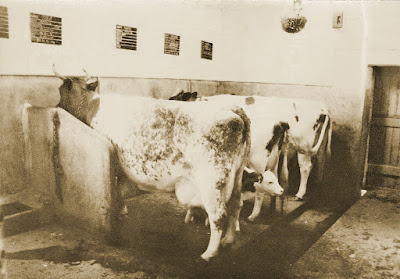1940-1996: Farming at Kilquhanity: Raison d’etre!
Undated and in pencil John Aitkenhead wrote
Kids and Cows
I often think that if I wasn’t a schoolmaster looking after kids, I’d be a crofter, looking after cows. As it is I am very happy being both even if the double job is sometimes waring. Perhaps the mixture has inherent compensations in the way of relaxation. I have found myself very relieved to . . . . . .to the quiet of the byre and enjoy the so called work of milking at an hour when a days work with children has earned a rest.
It’s soothing to sit and milk (if you know your cow!). You can think of things and make plans. At least so I find. Just as some students work well to the background noise of the wireless and many people can think better if they smoke, so I believe the rhythmic routine of milking in the warmth of contact with a cow, takes up just enough of one’s energies to free the mind for contemplation. Your modern milking machine has done away with all this – but then I am not all this concerned with these modern milk factories.
I well remember the first livestock I brought to the school – fifteen Khaki Cambell ducks from a neighbour. I tumbled them out of the sack they’d been in and stood looking at them. And the schoolkids excited at the new arrivals jumped around. ‘You’ll do I thought. We’ll have to learn your ways. And that’s just right. You’ll be true to your nature. You won’t cheat.’
Soon after there was the great thrill of our first cow. Susie she was christened with a very real lack of romance or imagination, and for six years she was all that. For six years she was true to her nature not cheating, so that we learned of her while she learned of us, (someone has said that animals don’t cheat because they can’t talk.
There’s probably a lot to that.) Susie was queen of the byre while our herd grew to be five cows strong. Then the happy day when she had twins, of opposite sexes they were Susanne and Sailor Boy – and the school learned the strange unhappy fact from the Vet that such twins are sterile. Susanne would be useless to breed as a cow, such a heifer could never have a calf while Sailor Boy would never be a bull.
This incident properly used:- What a lesson in biology! Proved to the hilt was my theory that having cows as an integral part of the school would be worth a hundred formal lessons in biology.
In general however the presence of our dairy stock and poultry has always been very significant. I feel that animals make te right tempo in a school. You can’t hurry them for our own convenience except at your own cost. Cows to be served, cows in calf, cows a’ calving, cows giving milk.
These in their natural sequence make meaning for a child. So a child in doing at Kilquhanity will be as familiar with the routine. And surely it is better from an educational point of view to have to have a glut of milk because a cow has calved or a scarcity because a calf is late, think always a steady supply because the milkman brings so many gallons a day.
. . . . . learning to milk is thrilling for children. Visibly they gain confidence, day by day, sitting close to the huge cow – or even when they are very young, crouching down and tugging at the soft udder till they’ve filled a mug. And as the days go past the amount of milk they can extract increases, and their pride knows no end. But always, always sure it is the child interest that dictates the activity, not the duty.
Here I imagine we have the happy compromise of a real farm which isyet small enough for the children to be allowed to participate. In fact small enough for the cows to become personalities like the humans – as was evidenced last month when Linda’s four year old included the names of the cows when he decorated his birthday cake with the initials of all the people in the school!
I think small numbers are important – both with cows and with kids. One has a chance to develop humane and kindly attitudes in general. Nobody could really love seventy or a hundred cows and as the individual animals in such a herd are seldom more than numbers and feeding time is rather a hectic grabbing of rations. Whereas, as Fraser Darling has observed in one of his books your cow that has love doesn’t need so much hay! (Students of economy – and economics might make a note of this. As a matter of fact!)
It seems to me, by and large, that consideration of the essentials that make for contented cows, would take us a fair way along the road in our search for the truth about contented kids – God knows we would do well to get along that road. For contented kids, are surely, the foundation of contented human beings. Yet paradoxically enough, there need be nothing cow-like in the resulting humans apart from a contentment.
It should be noted that John Aitkenhead is here, referring always to hand-milking.




